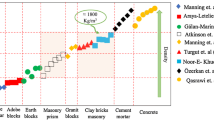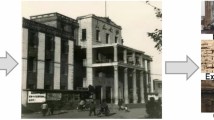Abstract
Relationships between brick compressive strength and results attained from different types of tests were explored in order to identify a suitable non-destructive assessment technique to predict the in situ material properties of vintage solid clay bricks. Empirical expressions were derived that related the brick unit compressive strength to the brick unit modulus of rupture strength and to the modulus of elasticity.










Similar content being viewed by others
References
Kaushik HB, Rai DC, Jain SK (2007) Stress-strain characteristics of clay brick masonry under uniaxial compression. J Mater Civil Eng 19(9):728–738
NZSEE (2006) Assessment and improvement of the structural performance of buildings in earthquakes. New Zealand Society for Earthquake Engineering, Wellington
Cultrone G, Sidraba I, Sebastián E (2005) Mineralogical and physical characterization of the bricks used in the construction of the “Triangul Bastion”, Riga (Latvia). Appl Clay Sci 28(1–4):297–308
Kreimeyer R (1987) Some notes on the firing colour of clay bricks. Appl Clay Sci 2(2):175–183
Karaman S, Gunal H, Ersahin S (2006) Assesment of clay bricks compressive strength using quantitative values of colour components. Constr Build Mater 20(5):348–354
Elert K, Cultrone G, Navarro CR, Sebastian Pardo E (2003) Durability of bricks used in the conservation of historic buildings—influence of composition and microstructure. J Cult Herit 4(2):91–99
Ahmad S, Iqbal Y, Ghani F (2008) Phase and microstructure of brick-clay soil and fired clay-bricks from some areas in Peshawar Pakistan. J Pak Mater Soc 2(1):33–39
Livingston RA, Stutzman PE, Schumann I (1998) Quantitative X-ray diffraction analysis of handmolded brick. In: Baer NS, Fritz S, Livingston RA (eds) Conservation of historic brick structures. Donhead Publishing Ltd, Shafesbury, pp 105–116
Sedmale GP, Shperberga IÉ, Ya Sedmalis U (2004) Formation of mullite based on hydromica clay—aluminium oxide compositions. Glass Ceram 61(1–2):48–51
Brozovsky J, Zach J (2007) Non-destructive testing of solid brick compression strength in structures. Paper presented at the IV Conferencia Panamericana de END, Buenos Aires, Argentina
Brozovsky J, Zach J, Brozovsky J Jr (2008) Determining the strength of solid burnt bricks in historical structures. Paper presented at the 9th international conference on NDT of Art, Jerusalem, Israel 25–30 May
ASTM (2000) Standard test methods for apparent porosity, water absorption, apparent specific gravity, and bulk density of burned refractory brick and shapes by boiling water. C 20 - 00. ASTM International, PA, USA
Tabor D (1956) The physical meaning of indentation and scratch hardness. Br J Appl Phys 7(5):159–166
Shalabi FI, Cording EJ, Al-Hattamleh OH (2007) Estimation of rock engineering properties using hardness tests. Eng Geol 90(3–4):138–147
ASTM (2003) Standard test methods for sampling and testing brick and structural clay tile. C 67 - 03a. ASTM International, PA, United States
Rilem (1998) MS-D.2. Determination of masonry rebound hardness (RILEM TC 127-MS). Mater Struct 31(6):375–377
MineralTown (2010) Minerals identification: Mohs scale of mineral hardness. MineralTown. http://www.mineraltown.com/infocoleccionar/mohs_scale_of_hardness.htm. Accessed September 27, 2010
Nicholson PT, Shaw I (2000) Ancient Egyptian materials and technology. The Press Syndicate of The University of Cambridge, Cambridge
Shi H, Atkinson M (1990) A friction effect in low-load hardness testing of copper and aluminium. J Mater Sci 25(4):2111–2114
Lumantarna R, Biggs D, Ingham J (2014) Uniaxial compressive strength and stiffness of field extracted and laboratory constructed masonry prisms. J Mater Civil Eng 26(4):567–575. doi:10.1061/(ASCE)MT.1943-5533.0000731
Cultrone G, Rodriguez Navarro C, Sebastian E, Cazalla O, de la Torre MJ (2001) Carbonate and silicate phase reactions during ceramic firing. Eur J Mineral 13:621–634
Institute of Statistics and Mathematics (2010) The R project for statistical computing. Institute of Statistics and Mathematics, Vienna
Peck R, Olsen C, Devore JL (2009) Introduction to statistics and data analysis, 3rd edn. Brooks/Cole, Cengage Learning, Belmont
Black K (2009) Business statistics: for contemporary decision making, 6th edn. Wiley, Jefferson City
Keselman HJ, Rogan JC (1978) A comparison of the modified-Tukey and Scheffe methods of multiple comparisons for pairwise contrasts. J Am Stat Assoc 73(361):47–52
Feir-Walsh BJ, Toothaker LE (1974) An empirical comparison of the anova F-test, normal scores test and Kruskal-Wallis test under violation of assumptions. Edu Psychol Meas 34(4):789–799
Bartoszyński R, Niewiadomska-Bugaj M (2008) Probability and statistical inference, 2nd edn. Wiley, Hoboken
Kottegoda NT, Rosso R (2008) Applied statistics for civil and environmental engineers, 2nd edn. Blackwell Publishing Ltd, Oxford
Acknowledgments
The authors would like to thank Anthony Waights from the Ceramic Advisory Services Australia for his advice on the brick mineralogy studies. Alec Asadov from the Department of Chemical and Materials Engineering of the University of Auckland also assisted in the X-ray diffraction studies. Many thanks go to Ali Omran and Waleed Numan, who during their undergraduate studies assisted in the experimental programme discussed herein. Much of this work would have been impossible without their involvement.
Author information
Authors and Affiliations
Corresponding author
Rights and permissions
About this article
Cite this article
Dizhur, D., Lumantarna, R., Biggs, D.T. et al. In-situ assessment of the physical and mechanical properties of vintage solid clay bricks. Mater Struct 50, 63 (2017). https://doi.org/10.1617/s11527-016-0939-9
Received:
Accepted:
Published:
DOI: https://doi.org/10.1617/s11527-016-0939-9




